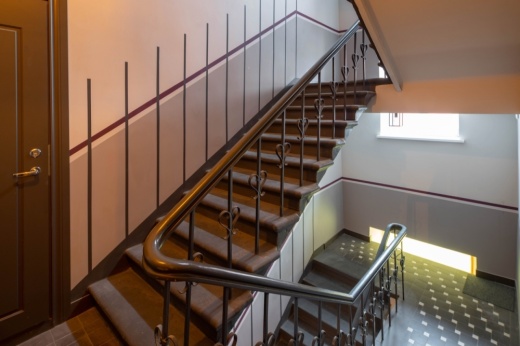“Austin has been leading the nation in new housing construction, and we are starting to see real results,” council member Chito Vela, who proposed the change last year, said in a statement. “Rents are finally coming down. This amendment helps us keep that momentum going by making it easier to build smaller, more affordable buildings that meet the needs of Austin families.”
The overview
Today, "double-loaded" apartments with multiple staircases connected by longer hallways are common for new multifamily construction in Austin. Under that model, units are placed on either side of a corridor and can have less square footage and window space than other housing types.
Multistory apartment buildings centered around one staircase are common internationally and in the U.S., including denser cities like New York and Seattle, but taller options aren't allowed in Austin. Starting July 10, those structures can be developed up to five stories high under newly adopted building code approved 10-1 by City Council in April

City officials pointed to the potential for better neighborhood walkability, larger family dwellings and improved lighting in units in their support for single-stair buildings.
“This item will help to diversify our housing supply and increase the number of multibedroom family units in our multifamily developments. And adding this type of flexibility in developments is yet another crucial step that this dais is taking to address our affordability challenges," council member José Velásquez said.We passed single stair in Austin! Thanks to everyone for their support! Let’s go!! pic.twitter.com/VZ4MUua06M
— Chito Vela III (@chitovela3) April 10, 2025
Put in perspective
Conor Kenny, principal with Austin builder Capital A Housing, told council members that single-stair options could be "the future of middle class and working class housing" in town.
"Fifty years from now, there will still be single-family homes in the city for families who can afford them, but working class and most middle class families will not," he said April 10. "Single-stair easily allows two-, three- and four-bedroom apartments and condos that families need."
Architect Chris Gannon, a single-stair supporter with AIA Austin, said the new building type could change how builders approach apartment construction in town with less intensive projects and more variety.
“These are smaller buildings so they can sit on a standard parcel; a developer doesn’t have to buy out an entire block to make multifamily work," he said in a 2024 interview. "If you’re walking down the street and you walked past five of these buildings, each one would be its own unique building. And that variation, that kind of fine-grained urbanism, is more pleasant for folks just in terms of walkability."
Ryan Saunders, a real estate broker and aspiring developer, said single-stair buildings could serve as community hubs without significantly changing an area's character.
“You could have four or five three-story or four-story single-stair [buildings] in a neighborhood, as opposed to having one massive full-block, beige, institutional apartment complex that has national tenants on the ground floor," he said in an interview.
Saunders also said the new housing may end up creating a better mix of rental spaces and condos, as opposed to projects under city programs like DB90 that tend to be larger and geared toward renting rather than long-term ownership.
Zooming in
Safety concerns were raised during public review of the new standards, including potential difficulties with accessing buildings in case of a fire.
Last year, the Austin Fire Department, Austin-Travis County EMS and Development Services Department had pointed to "significant" potential safety risks with the new building type. Staff noted differences in Austin's density, wildfire risk and longer fire department response times compared to other cities with more single-stair construction. Council member Marc Duchen, the lone vote against the new code, referenced those issues as reasons for his opposition to the update.
“My fear is that if we aren’t keeping up with our ladder trucks, and plus the other contextual factors of more traffic and more buildings, more construction, we have things that are not so easy to fix regarding making sure we can adequately respond to issues that might need to be increasingly addresses with this kind of housing," he said April 10.
Vela said single-stair buildings have good safety records in other places, and that he included "strong safety provisions" like square footage caps and fire-related requirements in his building code amendment.
"These buildings are limited to four units per floor, which means the stairs to exit in an emergency are just steps from your front door. We’ve added enhanced sprinkler systems and protected stairwells as an extra layer of fire protection," he said.
Council members also approved amendments calling for the city to complete annual reporting on the new developments, and to analyze the possibility of taller single-stair buildings with bigger floors in the future. A proposal from council member Zo Qadri aims to expand on the city's efforts to improve light access in residential buildings.





